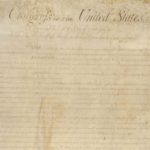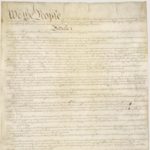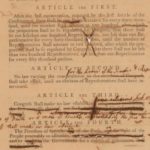The Bill of Rights is the first 10 amendments to the U.S. Constitution. These amendments guarantee essential rights and civil liberties, such as the freedom of religion, the right to free speech, the right to bear arms, trial by jury, and more, as well as reserving rights to the people and the states. After the Constitutional Convention, the absence of a bill of rights emerged as a central part of the ratification debates. Anti-Federalists, who opposed ratification, pointed to the missing bill of rights as a fatal flaw. Several states ratified the Constitution on the condition that a bill of rights be promptly added. Pop over to the National Constitution Center’s learning module to discover more!
Comparing the Magna Carta and English Bill of Rights with the U.S. Bill of Rights
In this activity students will examine the influences of the Magna Carta and the English Bill of Rights on the Bill of Rights in the U.S. Constitution. By the end of the activity students should be able to cite clear examples of the influence of English legal traditions in the U.S. Bill of Rights; they should also be able to give examples of how the American document is unique in offering even further expanded rights.
The Bill of Rights in Modern Times
In this lesson, students will learn about the individual rights that are included in the Bill of Rights and current issues relating to them. Students will use C-SPAN Classroom’s Constitution Clips to explore what each of these rights mean and determine how these rights apply to current events in America. This lesson works well with classes with one-to-one devices or in flipped classrooms.
Bill of Rights Booklet – Elementary and Middle Schools
Want your students to have their own Bill of Rights booklet? This booklet has the verbiage from the Bill of Rights and a space for students to be able to paraphrase what each amendment means.
Dialogue on the Fourteenth Amendment
The American Bar Association Dialogue program provides lawyers, judges and teachers with the resources they need to engage students and community members in a discussion of fundamental American legal principles and civic traditions. This Dialogue on the Fourteenth Amendment is composed of three parts:
Part 1: Equal Protection and Civil Rights – Participants discuss the equal protection clause of the 14th Amendment and consider how Congress, through federal legislation, has worked to help realize its constitutional promise.
Part 2: Incorporating the Bill of Rights examines the concept of incorporation. Using a case study of Gitlow v. New York, this section provides a guide to how courts have applied the Bill of Rights, selectively, to the states using the 14th Amendment.
Part 3: Ensuring Equality and Liberty explores how the 14th Amendment has been interpreted by courts to protect fundamental freedoms, including individuals’ right to marry.
Do I Have a Right?: Bill of Rights Edition (Game and Teacher Guide)
In the Bill of Rights edition of Do I Have a Right? your students run a law firm that specializes in constitutional law, specifically the rights protected in the Bill of Rights. Clients bring various complaints, and students must identify if they “have a right.” As students successfully resolve cases by matching them with the correct attorneys, their law firm grows along with the skills of their lawyers.
Bill of Rights

The Bill of Rights is on permanent display at the National Archives in Washington, DC. This original joint resolution of Congress proposed 12 amendments to the United States Constitution, but only 10 were ratified. Added to the Constitution in 1791 as the first 10 amendments, the Bill of Rights explicitly protected freedom of speech, of the press, of religion, and of assembly, among many other rights.
Creation of the Bill of Rights: “Retouching the Canvas”

This lesson will focus on the arguments either for or against the addition of a Bill of Rights between 1787 and 1789. By examining the views of prominent Americans in original documents, students will see that the issue at the heart of the debate was whether a Bill of Rights was necessary to secure and fulfill the objects of the American Revolution and the principles of the Declaration of Independence. Students will also gain an understanding of the origins of the Bill of Rights and how it came to be part of what Thomas Jefferson called “the American mind,” as well as a greater awareness of the difficulties that proponents had to overcome in order to add the first ten Amendments to the Constitution.
Congress and the Creation of the Bill of Rights

Students will explore the protections and limitations on authority contained in the Bill of Rights and the process by which the First Congress created it. They will do this by compiling a list of their rights as students, analyzing the Bill of Rights, and studying primary source documents to trace the origin and development of the first ten amendments. Students will then consider how the Bill of Rights might be updated to reflect 21st century circumstances. (Duration: 30–90-minute segments, up to 5 hours.)
James Madison and the Bill of Rights

This short video traces the evolution of James Madison’s thinking about the necessity of a Bill of Rights. While originally opposed to both a bill of rights and conditional ratification, Madison came to appreciate the political and the practical efficacy of both. Professor Jack Rakove notes that, unlike many bills of rights which use the phrase “the government ought not”, the American Bill of Rights says “the government shall not”, thus creating a set of legal commands to limit government.